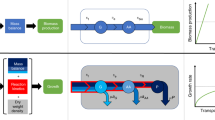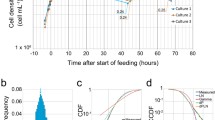Summary
HeLa cells have been grown at different rates in steady-state continuous and semicontinuous culture. Slowly growing cells contain more protein and less RNA than rapidly growing cells, but appear to synthesize protein by less efficient use of the available RNA. The rate of RNA accumulation increases rapidly with increasing growth rate and rapidly growing cells contain more ribosomal subunits, and more and larger polysomes, but have fewer monoribosomes than slowly growing cells.
Similar content being viewed by others
References
Rizzo, A. J., and T. E. Webb. 1969. Ribosone formation in rat liver: evidence for post-transcriptional control. Biochim. Biophys. Acta 195: 109–122.
Cooper, H. L. 1969. Ribosomal ribonucleic acid production and growth regulation in human lymphocytes. J. Biol. Chem. 214: 1946–1952.
Joklik, W. K., and T. Becker, 1965. Studies on the genesis of polyribosomes. I. Origin and significance of subribosomal particles. J. Mol. Biol. 13: 496–510.
Maden, B. E. H., M. H. Vaughan, J. R. Warner, and J. E. Darnell. 1969. Effects of valine deprivation on ribosome formation in HeLa cells. J. Mol. Biol. 45: 265–275.
Herbert, D., R. Ellsworth, and R. C. Telling. 1956. The continuous culture of bacteria: a theoretical and experimental study. J. Gen. Microbiol. 14: 601–622.
Sinclair, R. 1966. Steady state suspension culture and metabolism of strain L mouse cells in simple defined medium. Exp. Cell Res. 41: 20–33.
Eagle, H. 1959. Amino acid metabolism in mammalian cell cultures. Science 130: 432–437.
Burton, K. 1968. Determination of DNA concentration with diphenylamine. In: L. Grossman and K. Moldave (Eds.),Methods in Enzymology. Vol. 12B. Academic Press, New York, pp. 163–166.
Schneider, W. C. 1957. Determination of nucleic acids in tissues by pentose analysis. In: S. P. Colowick and N. O. Kaplan (Eds.),Methods in Enzymology. Vol. 3. Academic Press, New York, pp. 680–684.
Lowry, O. H., N. J. Rosebrough, A. L. Farr, and R. J. Randall. 1951. Protein measurement with the Folin-phenol reagent. J. Biol. Chem. 193: 265–275.
Penman, S. 1966. RNA metabolism in the HeLa cell nucleus. J. Mol. Biol. 17: 117–130.
Noll, H. 1967. Characterization of macromolecules by constant velocity sedimentation. Nature 215: 360–363.
Cohen, E. P., and H. Eagle. 1961. A simplified chemostat for the growth of mammalian cells: characterization of cell growth in continuous culture. J. Exp. Med. 113: 467–474.
Neidhardt, F. C. 1964. The regulation of RNA synthesis in bacteria. In: J. N. Davidson and W. E. Cohn (Eds.),Progress in Nucleic Acid Research and Molecular Biology, Vol. 3. Academic Press, New York, pp. 145–181.
Sykes, J., and T. W. Young. 1968. Studies on ribosomes and ribonucleic acids ofAerobacter aerogenes grown at different rates in a carbon-limited continuous culture. Biochim. Biophys. Acta 169: 103–116.
Koch, A. L., and C. S. Deppe. 1971.In vivo assay of protein synthesizing capacity ofEscherichia coli from slowly growing chemostat cultures. J. Mol. Biol. 55: 549–562.
Birch, J. R., and S. J. Pirt. 1970. Improvements in a chemically defined medium for the growth of mouse cells (strain LS) in suspension. J. Cell Sci. 7: 661–670.
Aiba, S., S. Nagai, Y. Nishizawa, and M. Onodera. 1967. Nucleic approach to some response of chemostatic culture ofAzotobacter vinelandii. J. Gen. Appl. Microbiol. 13: 85–101.
Ecker, T. E., and M. Schaechter. 1963. Ribosome content and the rate of growth ofSalmonella typhimurium. Biochim. Biophys. Acta 76: 275–279.
Hogan, B. L. M., and A. Korner. 1968. Ribosomal subunits of Landschütz ascites cells during changes in polysome distribution. Biochim. Biophys. Acta 169: 129–138.
Joklik, W. K., and Y. Becker. 1965. Studies on the genesis of polyribosomes. II. The association of nascent messenger RNA with the 40S subribosomal particles. J. Mol. Biol. 13: 511–520.
Henshaw, E. C., C. A. Hirsch, B. E. Morton, and H. H. Hiatt 1971. Control of protein synthesis in mammalian tissues through changes in ribosome activity. J. Biol. Chem. 246: 436–446.
Hosick, H. L., and R. C. Strohman. 1971. Changes in ribosome-polyribosome balances in chick muscle cells during tissue dissociation, development in culture, and exposure to simplified culture medium. J. Cell. Physiol. 77: 145–156.
Willems, M., and S. Penman. 1966. The mechanism of host cell protein synthesis inhibition by poliovirus. Virology 30: 355–367.
Attardi, B., B. Craviolo, and G. Attardi. 1969. Membrane-bound ribosomes in HeLa cells. I. Their proportion of total cell ribosome and their association with messenger RNA. J. Mol. Biol. 44: 47–70.
Richards, K., P. A. Kitos, and R. T. Hersh. 1972. Action of ribonuclease upon the polysomes of cultured mouse cells. In Vitro 8: 48–57.
Falvey, A. K., and T. Staehelin. 1970. Structure and function of mammalian ribosomes. I. Isolation and characterization of active liver ribosomal subunits. J. Mol. Biol. 53: 1–19.
Scharff, M. D., and J. W. Uhr. 1965. Functional ribosome unit of gamma-globulin synthesis. Science 148: 646–648.
Penman, S., C. Vesco, and M. Penman. 1968. Localization and kinetics of formation of nuclear heterodisperse RNA, cytoplasmic heterodisperse RNA and polyribosome-associated messenger RNA in HeLa cells. J. Mol. Biol. 34: 49–69.
McCormick, W., and S. Penman. 1969. Regulation of protein synthesis in HeLa cells. I. Translation at elevated temperatures. J. Mol. Biol. 39: 315–333.
Wilson, D. B., and H. Dintzis. 1969. Initiation of the α-chain of rabbit hemoglogin. Cold Spring Harbor Symp. Quant. Biol. 34: 313–316.
Subramian, A. R., B. D. Davis, and R. J. Beller. 1969. The ribosome dissociation factor and the ribosome-polysome cycle. Cold Spring Harbor Symp. Quant. Biol. 34: 223–230.
Author information
Authors and Affiliations
Additional information
This work has been supported by grant no. A-3458 from the National Research Council of Canada.
Rights and permissions
About this article
Cite this article
Daskal, I., Sinclair, R. Influence of growth rate on protein synthesis and distribution of ribosomes in HeLa cells. In Vitro 11, 338–346 (1975). https://doi.org/10.1007/BF02616369
Issue Date:
DOI: https://doi.org/10.1007/BF02616369




